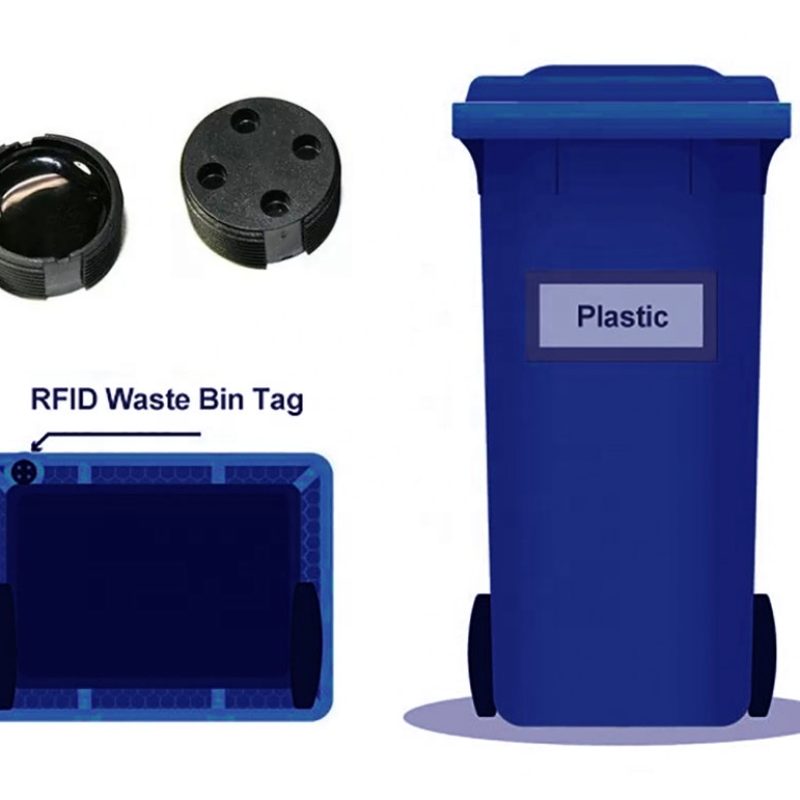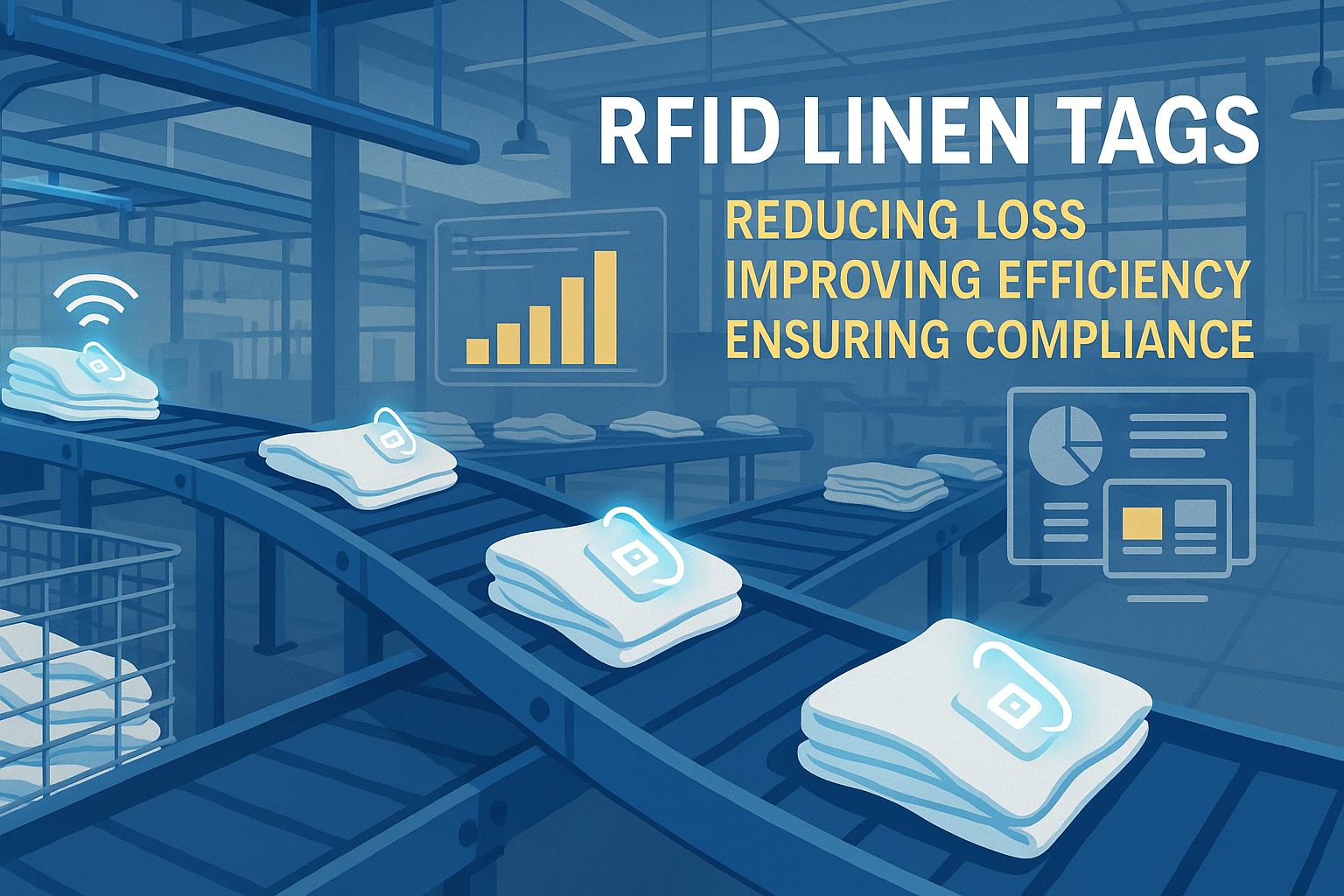
RFID 기반 폐기물 관리란 무엇인가
목차
RFID 기반 폐기물 관리 개요
“RFID(Radio-Frequency Identification)는 무선 주파수를 이용해 물품을 자동으로 식별하고 추적하는 기술입니다. 폐기물 관리 시스템에 적용될 경우, 도시와 기업이 쓰레기의 전체 이동 경로—수거부터 운반, 처리까지—를 추적할 수 있게 합니다. 이는 스마트 도시 인프라에서 가장 유망한 혁신 기술 중 하나로, 폐기물 수거를 보다 효율적이고 투명하며 환경적으로 책임감 있게 만드는 데 기여합니다.
RFID 폐기물 관리란 무엇인가?
RFID 폐기물 관리 시스템은 쓰레기통, 봉투 또는 수거용 카트에 소형 RFID 태그를 부착하는 방식으로 운영됩니다. 이 태그들은 수거 차량이나 분류 시설에 설치된 RFID 리더기에 의해 스캔됩니다. 각 스캔 시점마다 시간, 위치, 쓰레기통 ID, 심지어 무게와 같은 데이터가 기록됩니다.
모든 쓰레기통에 디지털 신분증을 부여하는 것과 같습니다. 수거 차량이 지나갈 때 시스템은 정확히 어떤 쓰레기통이 언제, 어떤 차량에 의해 수거되었는지 파악합니다. 이를 통해 수거 과정의 완전한 추적성과 자동화가 가능해집니다.
예를 들어, 도시와 민간 운영사들은 현재 RFID 쓰레기통 태그 가정용 쓰레기 수거용기에 부착하여 수거 확인, 누락된 수거 감소 및 자동 청구 기능을 구현합니다.

RFID 폐기물 관리 시스템의 작동 방식
모든 RFID 폐기물 관리 시스템은 세 가지 주요 구성 요소를 포함합니다:
- RFID 태그: 쓰레기통이나 용기에 부착된 소형 전자 칩.
- RFID 리더기: 쓰레기 수거차량이나 수거 지점에 장착되어 태그를 스캔하는 장치들.
- 백엔드 소프트웨어: 데이터를 수집하고 분석하는 관리 플랫폼.
트럭이 지나갈 때 리더기는 근처 태그를 감지하고 각 수거함의 데이터(위치, 시간, 수거 확인)를 기록합니다. 이 정보는 데이터베이스로 전송되어 운영자가 대시보드, 성과 지표, 경로 이력을 확인할 수 있습니다.
고급 시스템은 RFID 쓰레기통 태그를 충전량이나 무게를 측정하는 센서와 통합합니다. GPS 및 경로 최적화 소프트웨어와 결합된 RFID는 도시가 정밀하게 쓰레기 수거를 효율화하는 데 도움을 줍니다.
폐기물 관리에서 RFID의 이점 및 활용 사례
도시와 기업들이 RFID 폐기물 관리 시스템을 도입하는 이유는 다음과 같습니다:
- 경로 최적화: 트럭은 빈 쓰레기통을 건너뛰어 연료와 시간을 절약합니다.
- 정확한 청구: 실제 배출된 쓰레기 양에 따라 주민들에게 요금을 부과하는 배출량 기반 요금제를 지원합니다.
- 더 나은 책임성: 각 쓰레기 수거 서비스는 기록되어 불만과 누락된 수거를 줄입니다.
- 향상된 재활용: RFID 데이터는 폐기물 유형을 식별하여 분류 및 재활용률을 개선하는 데 도움이 됩니다.
예를 들어, 지자체는 RFID 쓰레기통 태그를 사용하여 서비스 완료를 확인하고, 산업 시설은 유해 폐기물 추적을 위해 RFID를 활용하여 규정 준수 및 추적성을 보장합니다.
실제 사례 및 사례 연구
전 세계 도시들은 이미 RFID 기반 폐기물 관리 시스템을 도입해 현대화하고 있으며, 그 성과는 가시적으로 나타나고 있다.
암스테르담
암스테르담은 모든 가정용 쓰레기통에 RFID 태그를 부착했습니다. 그 결과는 분명했습니다:
- 15% 미수거 건수 감소
- 실시간 데이터를 활용한 효율적인 수거 경로
- 연료 소비량과 운전 시간의 상당한 감소
서울
서울시 음식물 쓰레기 사용량 기반 요금제는 RFID 쓰레기통 태그를 통해 배출량을 추적합니다. 주민들은 스마트 쓰레기통에 RFID 카드를 탭하면 시스템이 쓰레기 무게를 측정해 요금을 부과합니다. 일부 구에서는 이 시스템 덕분에 음식물 쓰레기가 301톤 이상 감소했다고 보고했습니다.
개인 운송업체
민간 폐기물 관리 기업들도 RFID 폐기물 관리 기술을 활용하여:
- 상업용 픽업 트럭을 실시간으로 추적
- 자동 청구
- 고객이 인지하기 전에 서비스 문제를 파악하십시오
RFID 대 바코드 쓰레기통 추적 시스템
RFID와 바코드는 모두 폐기물 수거함을 추적하는 데 사용되지만, 성능, 자동화 수준 및 내구성 측면에서 기술적 차이가 뚜렷합니다. 아래 표는 현대적 폐기물 관리 운영과 관련된 주요 영역에서 두 방식을 비교합니다.
| 특징 | RFID 쓰레기통 추적 시스템 | 바코드 쓰레기통 추적 |
|---|---|---|
| 스캔 방법 | 무선 주파수를 사용하며, 가시선이 필요하지 않습니다. 리더기는 수 미터 거리에서 태그를 자동으로 감지할 수 있습니다. | 직접 시야가 필요합니다. 작업자는 각 라벨을 수동으로 스캔해야 합니다. |
| 속도 및 효율성 | 높음 — 트럭이 이동 중일 때도 여러 개의 빈을 동시에 스캔할 수 있습니다. | 낮음 — 한 번에 하나의 쓰레기통만 스캔할 수 있어 수거 속도가 느려집니다. |
| 내구성 | RFID 쓰레기통 태그는 먼지, 습기 및 손상에 강합니다. | 바코드는 쉽게 퇴색하거나 먼지와 긁힘으로 가려질 수 있습니다. |
| 데이터 용량 | 빈 ID, 소유자, 무게, 이력 등 상세한 데이터를 저장할 수 있습니다. | 단순한 숫자 또는 영숫자 코드로 제한됩니다. |
| 자동화 가능성 | 완전 자동화 — IoT 센서, GPS 및 경로 최적화와 연동됩니다. | 수동 방식 — 스캔 및 기록을 위해 인력 작업자에 의존합니다. |
| 초기 비용 | 초기 비용은 높지만(태그 및 리더기), 자동화를 통한 장기적 투자 수익률(ROI). | 초기 비용은 낮지만, 지속적인 인건비와 오류 발생률이 높습니다. |
| 가장 적합한 | 스마트 도시, 산업 시설 및 자동화를 목표로 하는 민간 운송업체. | 기본적인 식별 기능이 필요한 소규모 운영 또는 저예산 시스템. |
요약하자면, RFID 폐기물 관리는 확장 가능한 자동화 솔루션을 제공하는 반면, 바코드 추적은 여전히 저비용의 초보자용 옵션으로 남아 있습니다. 장기적인 효율성을 추구하는 도시와 기관에게는 RFID 쓰레기통 태그가 더 현명한 투자입니다.
산업 폐기물 흐름에서의 RFID 기반 폐기물 관리
RFID 기반 폐기물 관리 시스템은 산업 폐기물 추적 방식도 혁신하고 있습니다. 제조, 건설, 의료 분야에서는 규정 준수 및 추적 가능성이 필수적입니다.
RFID 쓰레기통 태그를 활용하면 기업은 폐기물 용기의 발생부터 운반, 최종 처분에 이르기까지 모든 이동 경로를 기록할 수 있습니다. 태그는 시간 기록, 처리 담당자, 이동 경로를 포착하여 완전한 관리 이력 가시성을 보장합니다.
예를 들어 병원에서는 생물학적 위험물 용기 추적에 RFID를 활용하며, 자동차 공장에서는 고철 및 화학 폐기물 관리에 이를 사용합니다. 이 데이터는 규정 준수를 향상시킬 뿐만 아니라 자재 흐름 및 폐기 처리 과정의 비효율성을 파악하는 데에도 기여합니다.
엄격한 감사나 지속가능성 보고를 요구받는 산업 분야를 위해, RFID 기반 폐기물 관리 시스템은 신뢰할 수 있고 변조 불가능한 기록과 실시간 운영 정보를 제공합니다.
RFID 기반 폐기물 관리가 수거 비용을 절감할 수 있을까?
물론입니다. RFID 폐기물 관리에 내장된 자동화는 직접적으로 비용 절감으로 이어집니다.
실시간으로 어떤 쓰레기통이 가득 찼는지 파악할 수 있어 트럭이 불필요한 정차를 생략할 수 있습니다. 이는 연료 소비, 노동 시간 및 차량 마모를 줄여줍니다. 암스테르담 같은 도시들은 RFID 쓰레기통 태그를 도입한 후 수거 누락과 운영 비효율성이 크게 감소했다고 보고했습니다.
민간 수거업체 역시 혜택을 누립니다: 자동화된 수거 확인 시스템은 분쟁과 서류 작업을 최소화하며, 경로 최적화 소프트웨어는 총 주행 거리를 줄입니다. 시간이 지남에 따라 수집된 데이터는 더 스마트한 계획 수립을 가능하게 하여 — 수거 빈도와 쓰레기통 배치를 조정해 효율성을 극대화합니다.
RFID 하드웨어에 대한 초기 투자는 바코드보다 높지만, 대부분의 운영사는 물류, 연료 및 관리 비용 절감을 통해 1~3년 이내에 투자 수익률(ROI)을 달성합니다.
도전 과제, 함정 및 고려 사항
최고의 RFID 폐기물 관리 시스템에도 장애물이 존재한다:
- 비용: 태그, 리더기 및 통합에 대한 선행 지출.
- 기술적 요인: 판독 범위는 빈 재질이나 환경 조건에 의해 영향을 받을 수 있습니다.
- 데이터 프라이버시: 쓰레기통 ID를 가구와 연결하는 것은 신중한 데이터 보호가 필요합니다.
- 지속가능성: RFID 칩에는 책임감 있게 재활용되어야 하는 전자 부품이 포함되어 있습니다.
- 교육: 근로자와 IT 팀은 새 시스템에 대한 오리엔테이션이 필요합니다.
확대 운영 전에 파일럿 운영을 먼저 진행하는 것이 하드웨어 및 데이터 처리를 미세 조정하는 최선의 방법이다.
RFID 기반 폐기물 관리 시스템 구축 단계
RFID 기반 폐기물 관리를 검토 중인 지자체 또는 기업을 위한 명확한 로드맵은 다음과 같습니다:
- 목표 설정: 예시, 수거 누락 건수 20% 감소, 재활용률 15% 향상.
- 현재 시스템 감사: 사용 중인 쓰레기통 유형, 수거 경로 및 디지털 도구를 파악합니다.
- 하드웨어 및 소프트웨어 선택: 수동형 또는 능동형 RFID 빈 태그와 호환 가능한 리더기를 선택하십시오.
- 파일럿 운영: 한 지역 또는 시설에서 시험 운영을 실시하십시오.
- 확대: 적용 범위를 확장하고 청구 및 분석과 통합합니다.
- 모니터링 및 최적화: RFID 데이터를 지속적으로 활용하여 운영을 개선합니다.
근로자, 주민 및 이해관계자와의 조기 소통은 원활한 도입과 명확한 의사소통을 보장합니다.
미래 동향 및 향후 계획
RFID 기반 폐기물 관리의 미래는 스마트 기술과의 심층적 통합에 달려 있습니다:
- IoT 센서: RFID를 레벨 또는 중량 센서와 결합하여 실시간 모니터링을 수행하십시오.
- 인공지능 및 분석: 경로를 예측하고 이상 현상을 자동으로 감지합니다.
- 순환 경제 추적: 수거된 자재가 재활용될 때까지 추적합니다.
- 친환경 태그: 재활용 가능하거나 생분해성 RFID 쓰레기통 태그 개발.
- 글로벌 채택: 신흥 시장들이 RFID를 스마트 시티 계획에 통합하고 있다.
사람들이 자주 묻는 질문(FAQ)
도시들이 왜 바코드에서 RFID로 폐기물 관리 방식을 전환하고 있을까?
RFID는 수동 스캔을 없애줍니다. 자동 컨테이너 감지, 실시간 추적, 경로 최적화 소프트웨어와의 연동을 가능하게 하는데, 이는 바코드가 제공할 수 없는 기능들입니다.
RFID 쓰레기통 태그는 모든 종류의 폐기물 용기에서 작동합니까?
네. RFID 쓰레기통 태그는 다양한 소재(나일론, ABS, 에폭시)로 제작되며 열, 비, 기계적 스트레스에 견딜 수 있도록 설계되었습니다. 금속 쓰레기통이나 지하 쓰레기통용 특수 모델도 존재합니다.
RFID와 바코드를 함께 사용할 수 있나요?
일부 하이브리드 시스템은 RFID가 주요 데이터 수집을 처리하는 동안 백업 또는 시각적 참조용으로 바코드를 사용하기도 합니다. 그러나 대부분의 현대식 RFID 폐기물 관리 솔루션은 속도와 자동화를 위해 RFID에 전적으로 의존합니다.
RFID 쓰레기통 태그는 비싼가요?
개별 태그는 상대적으로 비용이 낮습니다. 주요 투자는 리더기와 시스템 통합에 있지만, 인력과 연료 절감으로 인한 운영 비용 절감이 이러한 비용을 빠르게 상쇄합니다.
RFID 데이터는 안전한가요?
예. 현대식 RFID 시스템은 태그와 리더기 간 암호화된 통신을 사용하여 민감한 수집 또는 청구 데이터가 보호되도록 보장합니다.
결론
RFID 기반 폐기물 관리 시스템은 폐기물 수집 및 모니터링 방식을 혁신적으로 변화시키고 있습니다. 이를 통해 폐기물 관리가 더 스마트하고, 깨끗하며, 책임감 있게 이루어지고 있습니다.
RFID 쓰레기통 태그, 리더기 및 분석 기술을 결합함으로써 도시와 기업은 비용을 절감하고 서비스 신뢰성을 향상시키며 지속가능성 목표를 강화할 수 있습니다. 단순히 쓰레기통에 태그를 부착하는 것이 아니라, 폐기물 산업을 위한 연결되고 효율적인 생태계를 구축하는 것입니다.
조직에서 수거 비용을 절감하거나 규정 준수 요건을 충족하거나 데이터 기반 운영으로 전환하고자 한다면, 소규모 RFID 시범 운영을 시작하여 그 효과를 측정하십시오 — 한 번에 한 개의 수거함, 한 개의 노선, 한 개의 도시씩 진행하세요.

레이 저우
이 글은 업계에서 10년 이상의 경력을 쌓은 RFID 기술 전문가인 Ray Zhou가 작성했습니다.
댓글
인기상품

RFID 기반 폐기물 관리란 무엇인가
모든 쓰레기통이 말을 하는 도시를 상상해 보세요. 말 그대로가 아니라, 작은 칩을 통해 시스템에 쓰레기통이 가득 찼을 때, 비워졌을 때, 그리고 어디로 이동했는지를 알려주는 것입니다. 이것이 바로 오늘날 RFID 폐기물 관리가 수행하는 역할입니다.

볼트 씰이란 무엇이며 어떤 용도로 사용되나요? | 전체 가이드
글로벌 무역 및 물류에서 볼트 씰은 화물의 보안과 규정 준수에 중요한 역할을 합니다. 이 작지만 강력한 장치는 운송 컨테이너, 트레일러 및 화물 도어를 변조 방지 메커니즘으로 잠그도록 설계되었습니다.

RFID 카드 프로텍터란 무엇인가요? 장점, 사용 사례 및 구매 가이드
RFID(무선 주파수 식별) 기술은 신용카드, 신분증, 대중교통 패스, 호텔 객실 열쇠 등 어디에나 있습니다. 이 기술은 속도와 편리함을 제공하지만 "스키밍"이라는 새로운 종류의 디지털 도난에 대한 문을 열어주기도 합니다. 이것이 바로 RFID 카드 프로텍터가 필요한 이유입니다.

이벤트용 RFID 손목 밴드: 주최자를 위한 대량 구매 가이드
이벤트용 RFID 손목 밴드는 콘서트, 축제, 스포츠 경기장에서 더 빠른 입장, 사기 방지, 현금 없는 결제가 필요한 주최자가 선호하는 솔루션으로 자리 잡고 있습니다. 종이 티켓이나 QR코드와 달리 이러한 스마트 손목 밴드는 내장된 칩을 사용하여 액세스를 간소화하고 거래를 보호하며 게스트 경험을 개선합니다.

윈드스크린의 RFID 태그가 차량 출입 통제 및 통행료 시스템을 개선하는 방법
오늘날과 같이 빠르게 변화하는 세상에서는 차량 식별이 빠르고 안전하며 비접촉식으로 이루어져야 합니다. 윈드스크린의 RFID 태그는 차량을 정차하지 않고도 통행료 징수, 주차, 게이트 출입을 관리할 수 있는 안정적인 방법을 제공합니다.

상업용 세탁에서 RFID 린넨 태그의 이점
병원, 호텔 또는 대형 세탁 서비스에서 세탁물을 관리하는 것은 큰 일입니다. 매일 수천 장의 시트, 수건, 유니폼을 세탁하고 분류하여 다시 보내야 합니다. 하지만 린넨 분실, 분류 실수, 수작업 계수 등의 문제로 인해 회사에 많은 비용이 발생할 수 있습니다. 예를 들어, 중형 호텔의 경우 린넨 분실로 인해 매년 100만 달러 이상의 손실이 발생할 수 있습니다.
이것이 바로 RFID 리넨 태그가 필요한 이유입니다.




